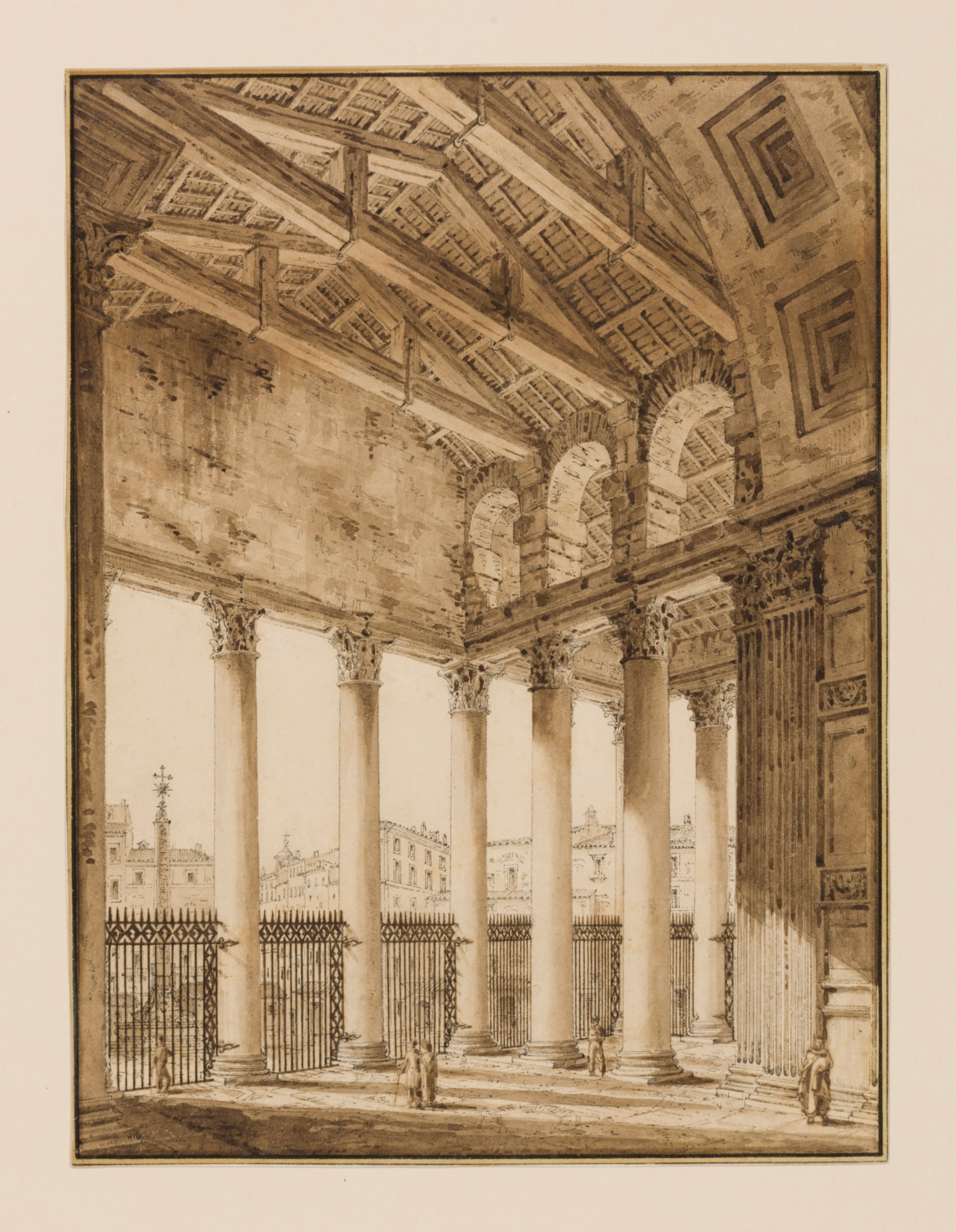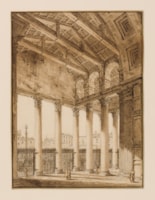Victor-Jean NICOLLE
(Paris 1754 - Paris 1826)
The Portico of the Pantheon, Rome
Sold
Pen and brown ink and brown wash, within a fictive mount with double framing lines in brown ink.
220 x 164 mm. (8 5/8 x 6 1/2 in.)
220 x 164 mm. (8 5/8 x 6 1/2 in.)
Victor-Jean Nicolle has been described as ‘a conscientious and precise draughtsman, somewhat cold but not devoid of a certain poetic power.’1He almost never dated his drawings, so a chronology of his oeuvre as a draughtsman is difficult to establish. Nevertheless, the present sheet may be approximately dated to the artist’s second period in Rome, between 1806 and 1811. Nicolle treated the subject of the Pantheon in Rome several times, although usually with the ancient building viewed from the front, with the Piazza della Rotonda in the foreground, as seen in an oval watercolour in the National Gallery of Art in Washington D.C. and another in the Musée des Beaux-Arts in Rouen.
As has been noted of the artist, ‘His innumerable drawings, in various techniques of which watercolour seems to have been the favourite, have a scrupulous regard for accuracy which makes them of particular value as historical documents. His line may have something of the dry precision of an architect’s tracing, but this is relieved by his feeling for the picturesque, by his precise observation of minute details, and by the sense of atmosphere which he conveys with the clear light of his transparent washes.’
Furthermore, as Pierre Rosenberg and François Bergot have written, ‘Nicolle appears to have been sensitive to the charms of ancient ruins as to the picturesque qualities of street scenes in a Rome where the past and present are felicitously interwoven, in a calm, deserted Rome, bathed in a streak of morning light.’
Otto Wittmann (1911-2001) worked for thirty years at the Toledo Museum of Art, becoming its director in 1959, and is credited with establishing the museum’s collection as one of the finest in America. On his retirement from Toledo in 1977, he served as a trustee, consultant and curator at the J. Paul Getty Museum in Malibu, between 1979 and 1989.
As has been noted of the artist, ‘His innumerable drawings, in various techniques of which watercolour seems to have been the favourite, have a scrupulous regard for accuracy which makes them of particular value as historical documents. His line may have something of the dry precision of an architect’s tracing, but this is relieved by his feeling for the picturesque, by his precise observation of minute details, and by the sense of atmosphere which he conveys with the clear light of his transparent washes.’
Furthermore, as Pierre Rosenberg and François Bergot have written, ‘Nicolle appears to have been sensitive to the charms of ancient ruins as to the picturesque qualities of street scenes in a Rome where the past and present are felicitously interwoven, in a calm, deserted Rome, bathed in a streak of morning light.’
Otto Wittmann (1911-2001) worked for thirty years at the Toledo Museum of Art, becoming its director in 1959, and is credited with establishing the museum’s collection as one of the finest in America. On his retirement from Toledo in 1977, he served as a trustee, consultant and curator at the J. Paul Getty Museum in Malibu, between 1979 and 1989.
Like many French artists of his day, Victor-Jean Nicolle was captivated by the sights and buildings of Rome, although he surpassed most of his contemporaries in devoting much of his long career to watercolour views of the Eternal City. His initial artistic training in Paris was as a student at the Ecole Royale Gratuite de Dessin, where in 1771 he won the grand prix de perspective, and he later entered the studio of the architect Louis Charles Petit-Radel. He never became a member of the Académie Royale in Paris, however. Judging by the dates on some of his drawings, Nicolle spent long periods in Italy between 1787 and 1798, and again between 1806 and 1811. His charming, picturesque drawings of Rome, while full of anecdotal detail, were also topographically accurate. They are, as such, important historical records of the appearance of the city in the late 18th and early 19th centuries. Inspired by the example of Hubert Robert, Nicolle also produced a number of architectural capriccios.
Nicolle would generally make drawings 'sur le motif' in pen and ink, which he would then finish with watercolour in his studio. Although best known for his Roman views, he also produced drawings of other cities in Italy, including Bologna, Venice, Verona, Naples and Florence, while in France he made numerous studies of Paris and its environs. (Only a handful of paintings by the artist are known.) Although he never exhibited at the Salons, his reputation as a topographical artist was such that in 1810 he received a commission from Napoleon for fifty watercolour views of the principal monuments of Paris, intended as a wedding present for the Empress Marie-Louise and now at Malmaison. Other significant groups of drawings by Nicolle are today in the Louvre, the Musée Carnavalet and the Bibliothèque Nationale in Paris, as well as the museums of Rouen and Lille.
Nicolle would generally make drawings 'sur le motif' in pen and ink, which he would then finish with watercolour in his studio. Although best known for his Roman views, he also produced drawings of other cities in Italy, including Bologna, Venice, Verona, Naples and Florence, while in France he made numerous studies of Paris and its environs. (Only a handful of paintings by the artist are known.) Although he never exhibited at the Salons, his reputation as a topographical artist was such that in 1810 he received a commission from Napoleon for fifty watercolour views of the principal monuments of Paris, intended as a wedding present for the Empress Marie-Louise and now at Malmaison. Other significant groups of drawings by Nicolle are today in the Louvre, the Musée Carnavalet and the Bibliothèque Nationale in Paris, as well as the museums of Rouen and Lille.
Provenance
Possibly part of an album of 240 drawings by Nicolle, assembled around 1818 by Colnaghi in London, and later belonging to Jean Camille Jammes, Paris
Possibly his sale (‘Victor-Jean Nicolle: Dessins, Aquarelles, Gouaches…Provenant d’un album appartenant à Monsieur J. C. J.’), Paris, Hôtel Drouot [Ader], 5 November 1953, lot 87 (‘Le peristyle du Panthéon’ Aquarelle. 19,5 x 13,5.’)
Otto Wittmann, Montecito, CA.
Possibly his sale (‘Victor-Jean Nicolle: Dessins, Aquarelles, Gouaches…Provenant d’un album appartenant à Monsieur J. C. J.’), Paris, Hôtel Drouot [Ader], 5 November 1953, lot 87 (‘Le peristyle du Panthéon’ Aquarelle. 19,5 x 13,5.’)
Otto Wittmann, Montecito, CA.





